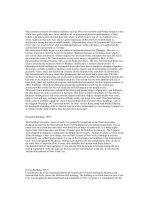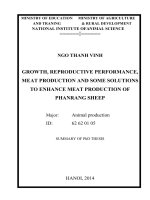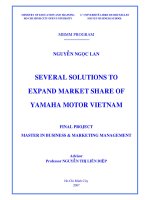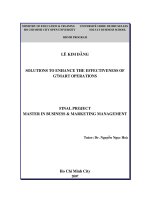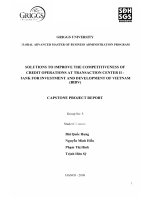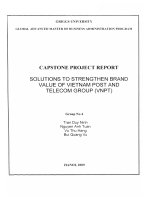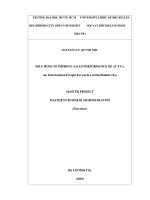proposal solutions to enhance market share of nissan grand livina in vietnam’s auto market
Bạn đang xem bản rút gọn của tài liệu. Xem và tải ngay bản đầy đủ của tài liệu tại đây (856.34 KB, 45 trang )
TRƯỜNG ĐẠI HỌC MỞ TPHCM
HO CHI MINH CITY OPEN UNIVERSITY
UNIVERSITÉ LIBRE DE BRUXELLES
SOLVAY BRUSSELS SCHOOL
MBMM5
DAO HOANG TRONG
PROPOSAL SOLUTIONS
TO ENHANCE MARKET SHARE OF NISSAN GRAND LIVINA
IN VIETNAM’S AUTO MARKET
MASTER PROJECT
MASTER IN BUSINESS & MARKETING MANAGEMENT
Tutor’s Name: Dr. TRINH THUY ANH
Ho Chi Minh City
(2012)
COMMITMENT
I am Dao Hoang Trong, a student of Master in Business and Marketing
Management Program 5 of Solvay Business School and Open University of HCM
City.
I commit that:
-
This project was studied and written by myself with best guidance of my
tutor.
-
All information was collected from reliable sources and practical interview
results with supports of my mentors.
-
No plagiarism
Best regards
Dao Hoang Trong
Monday, February 15, 2012
ACKNOWLEDGEMENTS
First of all, I would like to express my gratitude to Dr. Trinh Thuy Anh for
kind advices, valuable guidance and comments for my project
I wish also to say thank you very much Mr. Nguyen Huu Nhan _ Director of
Nissan Mien Tay for his advices and valid data to study Vietnam auto market
I wish to express my great appreciation to my colleagues, friends and
managers of car dealers who spent time to help me complete interviews and
questionnaires
Thanks my classmates in MBMM5 for useful recommendations
I would like to say special thanks and best wish to Master in Business and
Marketing Management Program of Solvay Business School and Open University
of HCM City
Finally, I thank my family for assisting me in during my research.
CONTENTS
---o0o---
Executive Summary
I.
INTRODUCTION
1.1 Rationale of project ....................................................................................... 2
1.2 Objectives of project .................................................................................... 3
1.3 Scope of project ............................................................................................ 3
1.4 Research methods ......................................................................................... 4
1.5 Project Structure ............................................................................................ 4
II. PROBLEM AND SITUATION ANALYSIS
2.1 Problem Statement ........................................................................................ 5
2.2 External analysis ........................................................................................... 6
2.2.1 Macro environment _PESTEL Analysis........................................... 6
2.2.2 Vietnam’s Auto market analysis ....................................................... 9
2.2.3 Segmentation................................................................................... 13
2.2.4 Competition..................................................................................... 14
2.2.5 Customer Assessments.................................................................... 16
2.3 Internal Analysis ......................................................................................... 19
2.3.1 Nissan Overview ............................................................................. 19
2.3.2 Product analysis .............................................................................. 20
2.3.3 Pricing ............................................................................................ 21
2.3.4 Targeting & positioning .................................................................. 23
2.3.5 Distribution & Services System ...................................................... 23
2.3.6 Communication ............................................................................... 23
2.4 SWOT ......................................................................................................... 24
2.5 Conclusions................................................................................................. 25
III. RECOMMENDATION
3.1 Innovating products ................................................................................... 26
3.2 Re- positioning ........................................................................................... 27
3.3 Re-targeting................................................................................................ 27
3.4 Pricing ........................................................................................................ 27
3.5 Action Plan ................................................................................................ 28
IV. CONCLUSIONS ................................................................................................ 28
V. REFERENCES & APPENDIX
LIST OF ABREVIATIONS
ABS
: Anti-lock Brake System
AFTA
: ASEAN Free Trade Area
BA
: Brake Assist
CBU
: Complete Build Up
CKD
: Complete Knock-down
EBD
: Electronic Braking Distribution
FAB
: Feature – Attribute - Benefit
GSO
: General Statistics Office
MPV
: Multi-purpose Vehicle
NGL
: Nissan Grand Livina
SUV
: Sport-Utility Vehicle
VAMA
: Vietnam Automobile Manufacture’s Association
WTO
: World Trade Organization
LIST OF CHARTS
Chart 1: Growth of Vietnam’s auto market .............................................................. 10
Chart 2: Market share of passenger car in 2011........................................................ 12
Chart 3: Segmentation of Vietnam’s Auto market.................................................... 13
Chart 4: Market share of multi-purpose vehicle segment ......................................... 14
Chart 5: Competitors analysis ................................................................................... 15
Chart 6: Survey result of factors influenced on consumers’ buying behavior .......... 18
Chart 7: Sales volume of multi-purpose vehicle in 2011 .......................................... 21
Chart 8: Nissan Grand Livina Price & Sales Positioning Map ................................. 22
Chart 9: Willing to pay measurement ....................................................................... 22
1
Executive Summary
With the advantage of a stable political environment, Vietnam’s economic is
developing strongly. Growth of GDP is increasing readily in recent years, average
6.78% for 2010-2011. As forecasting of analysts, annual GDP growth accelerate to
an average 7.2% from 2012-2014. Development of economic make high demands
of products; among that demand of using cars is increasing quickly. Most of
automakers penetrate and invest to Vietnam and get big success. In spite of being a
renowned car maker and joining Vietnam’ market two years ago, Nissan do not get
the market share yet that commensurate with their brand, just about 2% in very
attractive and high potential market.
Observing and recognizing this problem, the writer wants to apply knowledge
in marketing to study Vietnam’s auto market to find out causes of problem and
propose solutions to improve shares of Nissan Vietnam. The project just focuses to
share of Nissan Grand Livina, which is the first vehicle model, is being assembled
in local as CKD type.
To understand market, firstly the exploratory research is implemented by face
to face interview with professional salespersons, managers of car dealers in
HoChiMinh city included Toyota Ben Thanh, Mitsubishi Isamco, An Thai
Joinstock, SaigonFord and Nissan Mien Tay. Secondly, data of market were
collected from various secondary sources. The survey had also been done with 100
end users to understand consumer’s behaviors, purchasing decision process
After studying and analyzing, root causes of the problem were identified.
Basing on literature review and collected data, the writer can suggest improvement
steps to solve problem and increase shares.
Finally, the writer would like to propose solutions for managers of Nissan
Mien Tay who supports to study Vietnam’s auto market, especially multi-purpose
vehicle segment.
2
I.
INTRODUCTION
1.1
RATIONALE OF PROJECT
"The marketing concept is the philosophy that firms should analyze the needs
of their customers and then make decisions to satisfy those needs, better than the
competition " (Source: For any enterprises,
customers are who decide survival and development in business. It is very important
to satisfy customers in all business activities of enterprises if enterprises want to get
profit and grow. They have to study their customer needs, behaviors,… and then
making adequate business strategies to satisfy all customer’s requirements. No one
can negate the critical roles of marketing in modern business environment.
Marketing becomes more essential today because of fast development of hitechnology, globalization, continuously changing of world, more fierce competition,
therefore, absolutely all companies/organizations have to recognize great important
of marketing and have to build up strategies carefully if they want to get advantages
in competition with others and control the market share.
In automotive industry, not only is one of three best manufacturers of Japan
but also is one of top ten motor manufactures on the world, Nissan is a well-known
motor brand providing best passenger cars in many countries. Since December
2008, Nissan has penetrated Vietnam market as an importer and they distribute
Nissan’s products and spare parts, Nissan set up factory and dealer system in
Vietnam in 2010. Although Nissan brand is famous, the first model that was
launched in Vietnam is Nissan Grand Livina, this model does not meet consumers’
expectation yet, so that market share of this car is small.
What is the reason of problem and why? Can we apply marketing to find out
causes of problem and solutions?
Because of these above reasons, I choose the project “Proposal solutions to
enhance market share of Nissan Grand Livina in Vietnam’s auto market”; through
this project, I have condition to review knowledge studied in Master in Business &
3
Marketing Management Program of Solvay Economic School, I try to apply the
knowledge scientifically to study market, analyze causes and problems of Nissan
Grand Livina in Vietnam and then proposing solutions to increase market share of
this product.
I hope that my research will contribute added value for Nissan Mien Tay that
is a new dealer in Ho Chi Minh City to improve marketing and business activities to
meet needs of consumers.
1.2
PROJECT OBJECTIVES
The research aim to:
-
Study and analyze external factors, attractiveness of Vietnam’s auto
market, customers’ needs and buying behavior; focus to MPV
segmentation
-
Determine advantages and dis-advantages of Nissan Grand Livina and
strategy of Nissan Vietnam for this vehicle.
-
Identify root causes of small share of Nissan Grand Livina in Vietnam
-
Give proposal solutions to increase sales volume in three next years
1.3
SCOPE OF PROJECT
Due to limitation about the geography and time, the research just only is
implemented:
-
On market share of multi-purpose vehicle segment
-
Observation & face to face interview in HoChiMinh City (~70%)
-
Online, telephone survey in Binh Duong City and Hanoi Capital of
Vietnam (~30%)
4
1.4
RESEACH METHODS
The research method follows the process as following:
Identify research
objective & problem
- Objective: Review and apply marketing theory to
study market
- Why is the market share of Nissan Grand Livina
small?
Literature Review
- Review marketing knowledge
o Strategic Marketing Management_Jean
Baeyens
o Market Research _Jean Tondeur
o Business & Marketing Planning _ Olivier
Kupferman
o Marketing Management, Millenium Edition
2001_Philip Kotler
External & Internal
Analysis
- Primary research
o Face to face interview with 5 sales managers
of car dealers of Toyota, Ford, Mitsubishi,
General Motor and Nissan in HoChiMinh
City
o Survey on 100 persons who are using MPV
or looking for a new MPV.
- Secondary research: Data were collected various
sources such as VAMA, Vietnam Register, Nissan
reports, internet, magazine,…
- Analysis researched data and present results
Recommendations
- Innovate product and adjust strategy
- Operational actions plan
1.5
PROJECT STRUCTURE
The project consists of 5 parts:
-
Part 1
: Introduction of project
-
Part 2
: Problem statement and situation analysis
-
Part 3
: Recommendation
-
Part 4
: Conclusions
-
Part 5
: References & Appendix
5
II.
PROBLEM STATEMENT & SITUATION ANALYSIS
2.1 PROBLEM STATEMENTS
To develop automotive industry of countries, it is very important to choose the
key vehicle for long term development strategic. For example, pick-up truck has
been chosen as a key vehicle in the development strategy of Thailand automotive
industry and then Thailand has already become second largest pick-up truck market
on
the
world
and
ASEAN's
).
In
largest
Vietnam,
automotive
although
market
there
(Source:
are
many
recommendations of specialists that the government should choose multi-purpose
vehicle as a strategic vehicle, government has still not chosen a kind of key vehicle
to build up the long term development strategies for local automotive industry yet.
Actually MPV has became to the favorite vehicle for most of peoples and families
in Vietnam because of the convenience and suitable for many using purposes. The
demand to use a MPV for business and family is increasing continuously. Most of
auto makers in Vietnam have recognized this and focused to increasing in
production of MPV in order to meet demand of Vietnamese consumers, for instant
Toyota Vietnam introduces Zace, Innova; Mitsubishi produces Jolie, Zinger,
Grandis; General Motor Vietnam has Vivant; Ford Vietnam has Ford Everest; Kia
has Carens, Canival and a lot of import vehicle models.
Market is attractive and potential for auto makers, especially for Japanese
makers because of preferred of Vietnamese with Japanese products. However, some
of them do not get share that adequate with their reputation and resource, Nissan
Vietnam is a typical example. As a famous Japanese auto maker, Nissan choose
Grand Livina to introduce to Vietnamese consumers. Launching in April 2010,
Nissan Vietnam expects sales to total 2000 units in the first year, however, the
actual sales volume just only 433 units in first year, achieved 21,6% of target.
Although, accumulative sales increase positively in 2011; market share is still so
small at 1.4% (Source: Nissan Vietnam)
6
Even that penetrating Vietnam market, that is the developing market, later
than the others, they hoped that they can have good business because of good brand,
but the results of the first year do not commensurate with their image. The research
will present overview of market, opportunities and challenges for Nissan Grand
Livina to find out preferences as well as how long Nissan would take to familiarize
themselves with Vietnamese and then increasing market share.
2.2 EXTERNAL ANALYSIS
2.2.1 Macro environment (PESTEL Analysis)
Factors of macro environment always effect greatly on decisions of the board
of management of companies such as tax changes, trade barriers, and government
policy changes,…Therefore, analyzing and understanding these factors clearly will
support to make right decision in business for managers. The PESTEL model is
applied to analyze Vietnam’s macro environment and its effects on auto market.
-Political factors:
o First is tax policies, there are many kind of tax effect on car purchasing
in Vietnam such as import tax, special consumption tax, registration
tax. These taxes make high selling price of car; currently, price of car in
Vietnam is one of highest price on the world. Tax policies for auto
market are changed continuously. For instant, since 2011, decree no.
45/2011/NĐ-CP of government effect on 1 Sep 2011, increased vehicle
registration tax up to 20% car price. Briefly, tax is one of tools that
government is using to control auto market and then these policies
effect strongly on purchasing a vehicle of consumers.
o Second is gasoline price, consumers always mentions about fuel prices
because if this price increase then price of other product increase also.
For car consumers, gasoline price is an important element affect on
their purchasing decision. At present, domestic price is high at
20,800VNĐ despite world price tends decrease. (Source: http//www.
petrolimex.com.vn).
7
o Other political factors of government also effects on this market, for
instant trade balance, CPI, FDI. As collected information, government
tries to control trade deficit; current trade balance is as follow: Export
increase 35.4% ~ 70Bl US, import increase 26.9% ~ 76.9 bil US. The
government also makes effect to control the CPI. In 2010, CPI is 9.19%
but 9 months 2011 is 18.16% and forecast 2011 is 22%. FDI of 9
months 2011 reached 9.9 bil USD, increased 1.1% compared last year.
The changing of these factors will impact strongly on consuming
behaviors and purchasing decision of consumers also.
-Economic factors:
o In 2010, GDP of Vietnam is at 6.78% exceeding target of 6.5%; 9
months of 2011, GDP reached 5.76%, target at 7 – 7.5%. Increasing of
GDP affected on purchasing power, shopping needs changes positively.
However, Vietnam is facing with high inflation, this rate increase up to
17.5 %; forecast 2011 up to 18.8%. The devaluation of Vietnam Dong
is more seriously and high raising costs impact on consuming of people.
Another thing, bank interest rate is high at 19% - 24%., this factor effect
on car purchase decision because most of people like buy a car through
the bank. Exchange rate factor strongly influence on price of car, USD
price index increased continuously as the state bank stated.
o Recently, gold market have strong fluctuation, gold price is changing
sharply; people pay more attention in investing gold instead of
consuming. In addition, Vietnam stock exchanges critical bleak due to
tough economic context. This situation makes decrease of customer of
auto market seriously.
o In summary, there are both positive and negative factors but all of these
factors affected on Vietnam market clearly.
8
-Social:
o Vietnam population is young, about 87 mil, among that under 20 years
old is 39%; 20~29 is 20%; 30~39 is 15%; 40~49 is 12% and over 50 is
14%. The target customer for car business is about 18~40 years old,
occupy more than 60%. This is very large chance for investors. In
addition, the transportation habits of Vietnamese are private means
because of asynchronous development of traffic and infrastructure.
o Besides that, there are new trends and new demands currently; a lot of
young people want to replace motorcycle by cars or using public
transportation because they emphasis on safety or want to prove the
success or show-off.
-Technological: Changing of technological factors also effect on consuming
of Vietnamese such as fast development of automation or high technology.
Eco friendly technologies: saving energy, green environment,… are factors
that contribute to changing purchasing behavior of customer.
-Environmental: Awareness for environmental increase and government
appeal social responsibility
(Source: )
Summary: As collected data, although there are many changes in all aspects
of political, economic, social and other factors; in general macro environment
have a positive effect to the automobile business, for instants:
o High GDP growth
Make positive effects on purchasing power
o Tax policies are being changed to protect consumers when buying car
o Positive trend in consuming car
more persons want to own a private
car
This environment makes a high potential and attractiveness of auto
market for automakers
9
2.2.2 Vietnam Auto Market analysis
a. Economic overview: Viet Nam fully joined to AFTA in 1998 and WTO in
2007 (source: ); investors look up Vietnam has high
potential for further economic growth, average GDP from 2007 to 2011 is 6.5%
(Source: ). Simplification in business registration
procedures, tax waivers and preferential loans has being encouraged private
businesses to expand and attracting foreign investors. The government continues to
perfect its legal system, created more incentive policies for foreign investors and
fulfill its commitments to the international community. However, Vietnam is also
impacted of global economic crisis; the economy is in tough period, government has
to tighten monetary policies, lending and VND-USD exchange rates. It’s high
pressure pushing on the local auto market.
b. Transportation overview: According to the World Bank, Vietnam has
the speed of the fastest urbanization in Southeast Asia. In 1986, the percentage
of population living in urban areas in Vietnam is 19% (approximately 11.8 million
people) in
2010 has
increased to 30.5% (approximately
26.3 million
people).
Urbanization of outskirts of HoChiMinh City and Hanoi is accelerating strongly
through the development of road systems, buildings and infrastructure. In addition,
for economic of a country, automotive is one of most important industries because
this industry makes high revenue and meets transportation demands for social.
Recognizing this, in decision No.55/2007/QD-TTg of Prime Minister, Vietnam’s
government determined special roles of automotive industry in economic
development strategy of national and created good conditions for all local, foreign
investors to build and develop automotive field in Vietnam (Source: Vietnam
Economic Forum)
c. Vietnam Auto market: As Vietnam Register’ data, there are 1,274,084
vehicles which are licensed at the end of 2010. Accumulate of sales volume in 9
10
months of 2011 is 80,681 units, increase > 10% compared same period last year,
among that 54% is passenger cars (Source: Vietnam Register, VAMA). Despite
government issues some policies aiming to control too fast growth of private
vehicles in order to appropriate with growth of transport infrastructure, number of
cars are still being increased continuously. However, comparing with some country
in South East Asia such as Thailand or Indonesia, market size of Vietnam remains
small with around 150,000 car units per year
d. Growth rate of Vietnam’s auto market
70,000
60,000
50,000
40,000
62,723
30,000
49,356
20,000
27,366
31,577
10,000
8,820 12,942
19,319
17,923
57,779
40,115
25,300
0
2000 2001 2002 2003 2004 2005 2006 2007 2008 2009 2010
Sales volume
Expon. (Sales volume)
Source: VAMA
As graph, trend of auto market in Vietnam is increasing yearly. The average
growth is at 26% per year. Comparing with China and Thailand that are largest auto
markets in Asia, the developing speed of Vietnam’s auto market make deeply
impression for investors. The average growth of Thailand’s auto market is at 12% in
recent year and at 25% for China’s market. (Source: )
Vietnam
has
a
population
of
about 87 million
peoples,
the
rate
of car ownership is low at present (15vehicles/1.000 peoples), comparing with other
11
market on the world, Vietnam is not big market but full of potential and very active.
With the differentiate advantages, Vietnam has been attracted investors in local,
oversea to joining and playing in auto market.
e. Rivalry & attractiveness of market: Basing on Porter’s Five Force to analyze
Power of suppliers: Low
- Switching to another supplier is
difficult and/or expensive
- Increasing price of materials
Threats of potential entrants:
Rising
- Pressure from others
makers, especially China’s auto
makers with diversify models and
cheap prices
- Pressure from grey
market, importers.
Rivalry exiting competitors: High
- Fierce between many competitors with high
energy (Toyota, Kia, …)
- Diversify products of competitors
Threats of substitutes: Rising
- Public transportation means
because of imbalance between
private means and growth of
transportation infrastructure.
Power of customers: High
- Have enough powerful in dealing
because of having selection from
many brand
- Price sensitivity
Quality and services
- Power of suppliers: Power from suppliers to Nissan Vietnam is low because
main components that are assembled into Nissan Grand Livina are provided by
suppliers which are controlled by Nissan Global, it’s not easy for Nissan Vietnam
and supplier to switch. Therefore these suppliers cannot make high pressure on
Nissan Vietnam except increasing price of material.
- Threats of potential entrants: Not only enterprises of Vietnam but also
enterprises on other countries stand high pressure of China’s enterprises, this is big
threats and rising because of their strong development and flexible price. China’s
auto makers bring to market products with flexible price to attract customers.
12
- Power of customers:
customers It is high because
ecause of there are many car brands in
Vietnam market so that there are many choice for customers,
customer , this make high power
on car sellers about the price, quality and services.
services. The pressure from dealers to
makers is not so high. The important is cooperation between makers and dealers to
serve customers; high power of customer effect on both makers & dealers.
- Threats of substitutes:
substitutes: This threat is rising strongly because priority of
government for public
ic transportation
transportatio is increasing; low costs encourage people to
use public mean and limit to use private means. This is threat for car sellers like
Nissan Vietnam as well.
well
- Rivalry exiting competitors:
competitors: The pressures from directly competitors for
Nissan in Vietnam’s auto market is very high with many big brand like Toyota,
General Motor,, Mitsubishi, Ford,… and fierce completion of importers in grey
market.
f. The
he market share of passenger cars in 2011 as follow
24.9%
41.8%
2.2%
11.5%
19.6%
Toyota
Kia
Ford
Nissan
Others
Source: VAMA
In passenger car market, Toyota Vietnam is always a leader.
leader Kia is creating
the new power in spitee of just joining recently. It is very clear that market share of
Nissan do not adequate with
wi their brand name, just at 2.2%
Summary: Even though there are a lot of challenges from market such as
fierce rivalry of existing competitors, high pressure from new entrants, barriers of
government policies,… but the attractiveness and high growth of market create big
13
opportunities for auto makers like Nissan who has good reputation in manufacturing
car.
A survey about attitude of Vietnamese to car brands was done including
brands of Japan, Korea, China, United State and the results showed that brands of
Japan are preferred by Vietnam’s users with more than 90% agreed.
Therefore, Nissan has good chance to approach Vietnamese consumer.
2.2.3 Segmentation
As Philip Kotler, marketers start with market segmentation to identify and
profile distinct groups of buyers who might prefer or require varying products and
marketing mixes. (Source: Marketing Management, Millenium Edition 2001_Philip
Kotler). Companies analyze and choose a segment to allocate recourses and
prioritize investment; if having good segmentation analysis, companies are able to
use cost efficiency and build competitive strategies. For automotive, normally base
on characteristics of vehicles, segment of vehicle is defined as sedan, multi-purpose
vehicle (MPV), sport-utility vehicle (SUV), pick-up,... (Source: )
The segmentation of Vietnam’s auto market is displayed below
80,000
Pick-up segment
70,000
60,000
Minibus segment
50,000
SUV segment
40,000
MPV segment
30,000
20,000
Sedan segment
10,000
0
2007
2008
Sedan
MPV
2009
SUV
Minibus
2010
2011
Pick-up
Source: VAMA
The above data show that beside sedan segment which is various types such as
mini-car, small car, medium car,… is biggest segment; the increasing of MPV
14
segment higher than remain segments,, so that selecting this segment to invest and
approach this customer segment will be high appreciated about effect of investment
and save cost. This segment is potential and also has a lot of challenges,
competition.
2.2.4 Competition
At current situation, there
t
are a lot of players who are competing against each
other in Vietnam’s auto market consisting of VAMA’s members,
member other local
manufacturers which do not join to VAMA and importers. Therefore, competition is
increasing extremely fierce. Market competition will be even fiercer driven by
ASEAN’s tax reduction trajectory. It would be inevitable that some firms could not
survive tough conditions and
and go dismantled while some others jump into the
market.
Actually, most
ost of players have been interested in multi-purpose
multi
vehicle
segment since 2003; right after penetrated Vietnam market, they invest to assemble
multi-purpose
purpose vehicle,
vehicle for example Toyota assemble Zace, Innova; Mitsubishi
assemble Jolie, Zinger…
Zinger… importers also look for MPV models to bring to Vietnam.
Similarly other makers,
maker Nissan introduced Nissan Grand Liniva as a MPV at the
beginning time to approach this market in 2010
The market share of MPV segment as follow
12.1%
1.8%
29.3%
6.9%
7.8%
Toyota
Kia
Ford
Nissan
Others
Source: VAMA
15
For any segment of passenger car in Vietnam, Toyota always has taken
advantages of their inherent such as brand, service system,… to occupy the best
share (29.3% for MPV in 2011). As discussed with experience salespersons, they
said that most of Vietnamese think about Toyota when thinking about car similar to
they think about Honda when want to buy a motorcycle.
However, salespersons also commented that Vietnam social is changing day
by day, consuming behavior is also changing more positive and open because there
are more rich young men who have open and modern thinking. Therefore, not only
one a particular brand, opportunities for all brands to run business in Vietnam is
very big, of course competition is also more and more fierce.
Survey result about competitors in MPV segment is as below graph:
Brand
5
Re-sales
value
4
3
Price
Toyota
2
Kia
1
Nissan
0
Design &
Interior
Distribution
& Service
Quality &
durability
Ford
Mitsubishi
Convenience
&
comfortable
Source: Data of Survey
Nissan Vietnam positioning Grand Livina to MPV segment; the survey of
consumers’ evaluation between this car and other MPV of competitors was done;
the result is described on the above graph and summarized as follow:
-
Advantages
o Famous brand because of confidence of Vietnamese consumers for
Japan’ products
o Good quality & durability
16
-
Dis-advantages:
o Not good design MPV for Vietnam’s conditions
o Not good convenience and comfortable for passengers
o Not competitive price
Summary: Obviously, in MPV segment, Nissan Grand Livina does not satisfy
requirements for multi-purpose vehicle about appearance and convenience that is
the most important factors of this vehicle segment. These factors are the biggest disadvantage of Grand Livina via to competitors’ MPV.
2.2.5 Customers Assessments
To satisfy customers’ requirements, companies have to determine and analyze
exact customer’ needs, behaviors and buying trends. This will provide a foundation
for a company to understand their customers. So that identifying target customer is
priority important action of companies. As interview results with direct sale
managers of car dealers, the target customers of MPV segment are middle class
peoples in Vietnam.
Based on data of TNS Vietnam about the middle class people, basic
characteristics of the MPV’ customer segment were presented as follow:
-
Customer type: Persons who want to use the car for both daily business
commuting and outdoor activities
-
Demographics: Middle class (~20% population)
-
Ages: 30-40 year olds
-
Average income/month: 6,5 mil VND – 15mil VND
-
Geography: Urban
What are needs and behaviors of this target customer?
According to model of buying behavior of Philip Kotler, the behavior of
consumers is influenced by factors such as cultural, social, personal and
psychological. (Source: Marketing Management, Millenium Edition 2001_Philip
Kotler)
17
Basing on the model of Philip Kotler and recommendation of sales managers
about the factors influence on buying decision a car of Vietnamese consumers, the
factors are determined including brand; compliance of car with using needs and
convenience of car; price; design & appearance; engine & fuel consumption. The
advices or comments of their friends are just used for references.
To study these influence factors, a sampling survey was conducted on the
target customers. The sampling survey process is as below:
-
Step 1: Determine and choose random sampling method to research
-
Step 2: Applying Cochan’s formula to calculate sample size
o Where assume that
-
t: value for selected alpha level of 0.1 is 1.65
-
s: estimate of standard deviation in the population is 1.167,
estimated almost all of response in the range (~ 98%).
-
d: acceptable margin of error for mean being estimated =
0.21
o Sample size: n =
୲మ ାୱమ
ୢమ
=
(ଵ.ହ)మ ା(ଵ.ଵ)మ
(.ଶଵ)మ
= 84
o Sales volume of passenger car in 2010 is 57,779 units. Among
that, MPV volume is about 18%: 18% * 57,779 = 10,400 units.
This sample size is not exceeds 5% of the total population size of
MPV volume.
o As calculated results, the writer chooses sample size is 100 to
implement quantitative survey.
-
Step 3: The questionnaire has been designed to learn buying behavior of
the customer segment (see appendix).
-
Step 4: The quantitative survey was conducted as following
o Directly surveyed on 68 persons in HoChiMinh City who came to
auto show on November 2011 & visited showrooms of Nissan
Mien Tay & Toyota Ben Thanh
o On phone surveyed on 32 persons in Hanoi & Binh Duong City
